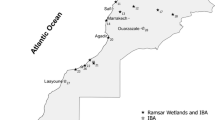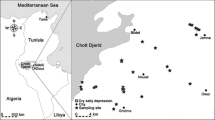Abstract
Determining the response of birds to local habitat characteristics and landscape structure is essential to understanding habitat selection and its consequences for the distribution of species. This study identified the influence of environmental factors as determinants of the waterbird assemblage composition in 39 wetlands in the Pampas of central Argentina. Multivariate analysis allowed the identification of environmental factors affecting the use of habitat by waterbird species, whose variable numbers were explained by local and landscape environmental factors. Interspecific variation in responses to changes in environmental factors shows that habitat selection occurs at a species-specific level, although species with similar ecological requirements tend to respond similarly to environmental heterogeneity. Plovers and flamingos were mostly associated with high salinity and the presence of a muddy shoreline and temporary ponds; ducks, herons and ibises were associated with vegetation abundance and decrease in salinity; piscivores and carnivorous species were associated with water depth. The small degree of overlap of habitat requirements between some species suggests a high level of specialization within waterbird assemblages. This knowledge can be used for the design of appropriate conservation and management strategies in central Argentina, where the alarming loss of wetlands requires management strategies that ensure the permanence of the greatest diversity of waterbirds.



Similar content being viewed by others
References
Bancroft GT, Gawlik DE, Rutchey K (2002) Distribution of wading birds relative to vegetation and water depths in the Northern Everglades of Florida, USA. Waterbirds 25:265–391
Barbaro L, Rossi JP, Nezan J, Jactel H (2007) The spatial distribution of birds and carabid beetles in pine plantation forests: the role of landscape composition and structure. J Biogeogr 34:652–664
Bibby C, Jones M, Marsden S (1998) Expedition field techniques, bird surveys. Expedition Advisory Centre. Royal Geographical Society, London
Blanco DE (1999) Los humedales como hábitat de aves acuáticas. In: Malvárez AI (ed) Tópicos sobre humedales subtropicales y templados de Sudamérica. ORCYT-UNESCO, Montevideo, pp 208–217
Blarasin M, Cabrera A, Matteoda E, Gómez M (2005a) Ascenso del nivel freático y cambios ambientales: diagnóstico hidrogeológico y propuesta de manejo en Coronel Moldes, Córdoba. In: Blarasin M, Degiovanni A, Cabrera A, Villegas M (eds) Aguas superficiales y subterráneas en el sur de Córdoba: una perspectiva geoambiental. Universidad Nacional de Río Cuarto, Río Cuarto, Córdoba, Argentina, pp 163–172
Blarasin M, Degiovanni A, Cabrera A, Villegas M, Sagripanti G (2005b) Factores naturales y antrópicos condicionantes de la dinámica hidrológica regional. In: Blarasin M, Degiovanni A, Cabrera A, Villegas M (eds) Aguas superficiales y subterráneas en el sur de Córdoba: una perspectiva geoambiental. Universidad Nacional de Río Cuarto, Río Cuarto, Córdoba, Argentina, pp 275–282
Bolduc F, Afton AD (2008) Monitoring waterbird abundance in wetlands: the importance of controlling results for variation in water depth. Ecol Model 216:402–408
Brandolin P, Ávalos MA (2010) Nuevos registros estivales de Flamenco Andino Phoenicoparrus andinus para la llanura central de Argentina, Provincia de Córdoba. Cotinga 32:5–7
Brandolin PG, Ávalos MA, De Angelo C (2013) The impact of flood control on the loss of wetlands in Argentina. Aquat Conserv 23:291–300
Cantero GA, Cantú MP, Cisneros JM et al (1998) Las tierras y aguas del sur de Córdoba—propuestas para un manejo sustentable. Universidad Nacional de Río Cuarto, Río Cuarto
Cantú MP, Degiovanni SB (1987) Génesis de los sistemas lagunares del centro-sur de la provincia de Córdoba República Argentina. Décimo Congreso Geológico Argentino, San Miguel de Tucumán. Actas III, pp 289–292
Collins SL, James FC, Risser PG (1982) Habitat relationships of wood warblers (Parulidae) in northern central Minnesota. Oikos 39:50–58
Colwell MA, Taft OW (2000) Waterbird communities in managed wetlands of varying water depth. Waterbirds 23:45–55
Cornell HV, Karlson RH (1997) Local and regional processes as control of species richness. In: Tilmant D, Kcreiva P (eds) Spacial ecology—the role of space in population dynamics and interspecific interactions. Princeton University Press, Princeton, pp 250–268
Cushman SA, McGarigal K (2002) Hierarchical, multi-scale decomposition of species-environment relationships. Landsc Ecol 17:637–646
Dunning JB, Danielson BJ, Pulliam HR (1992) Ecological processes that affect populations in complex landscapes. Oikos 65:169–175
Elphick CS (2008) Landscape effects on waterbird densities in California rice fields: taxonomic differences, scale-dependence, and conservation implications. Waterbirds 31:62–69
Elphick CS, Oring LW (1998) Winter management of Californian rice fields for waterbirds. J Appl Ecol 35:95–108
Gatto A, Quintana F, Yorio P (2008) Feeding behavior and habitat use in a waterbird assemblage at a marine wetland in coastal Patagonia, Argentina. Waterbirds 31:463–471
Gawlik DE (2002) The effects of prey availability on the numerical response of wading birds. Ecol Monogr 72:329–346
Githaiga-Mwicigi JMW, Fairbanks DHK, Midgley G (2002) Hierarchical processes define spatial pattern of avian assemblages restricted and endemic to the arid Karoo, South Africa. J Biogeogr 29:1067–1087
Hannam KM, Oring LW, Herzog MP (2003) Impacts of salinity on growth and behavior of American avocet chicks. Waterbirds 26:119–125
Holm KJ, Burger AE (2002) Foraging behavior and resource partitioning by diving birds during winter in areas of strong tidal currents. Waterbirds 25:312–325
Isola CR, Colwell MA, Taft OW, Safran RJ (2002) Interspecific differences in habitat use of shorebirds and waterfowl foraging in managed wetlands of California’s San Joaquin Valley. Waterbirds 25:196–203
Johnson AR, Wiens JA, Milne BT, Crist TO (1992) Animal movements and population dynamics in heterogeneous landscapes. Landsc Ecol 7:63–75
Kent M, Coker P (1992) Vegetation description and analysis—a practical approach. Wiley, New York
King S, Elphick CS, Guadagnin D, Taft O, Amano T (2010) Effects of landscape features on waterbird use of rice fields. Waterbirds 33:151–159
Kissling WD (2004) Effects of time of day and observer position on waterbird counts. Notornis 51:41–46
Lepŝ J, Smilauer P (2003) Multivariate analysis of ecological data using CANOCO. Cambridge University Press, Cambridge
Liordos V (2010) Foraging guilds of waterbirds wintering in a Mediterranean coastal wetland. Zool Stud 49:311–323
Ma Z, Cai Y, Li B, Chen J (2010) Managing wetland habitats for waterbirds: an international perspective. Wetlands 30:15–27
MacArthur RH, MacArthur JW, Preer J (1962) On bird species diversity: II prediction of bird censuses from habitat measurements. Am Nat 96:167–174
Margules CR, Pressey RL (2000) Systematic conservation planning. Nature 405:243–253
Martin TE, Blackburn GA (2012) Habitat associations of an insular Wallacean avifauna: a multi-scale approach for biodiversity proxies. Ecol Indic 23:491–500
Mayor SJ, Schneider DC, Schaefer JA, Mahoney SP (2009) Habitat selection at multiple scales. Ecoscience 12:238–247
Naugle DE, Johnson RR, Estey ME, Higgins KF (2000) A landscape approach to conserving wetland bird habitat in the prairie pothole region of eastern South Dakota. Wetlands 21:1–17
Palmer MW (1993) Putting things in even better order: the advantages of canonical correspondence analysis. Ecology 74:2215–2230
Pearman PB (2002) The scale of community structure: habitat variation and avian guilds in tropical forest understory. Ecol Monogr 72:19–39
Polis GA, Power ME, Huxel GR (2004) Food webs at the landscape level. University of Chicago Press, Chicago
Purdue JR, Haines H (1977) Salt water tolerance and water turnover in the snowy plover. Auk 94:248–255
Quirós R, Rennella A, Boveri M, Rosso JJ, Sosnovsky A (2002) Factores que afectan la estructura y el funcionamiento de las lagunas pampeanas. Ecología Austral 12:175–185
Ramesh DA, Ramachandran S (2005) Factors influencing flamingo (Phoenicopterus roseus) distribution in the Pulicat Lagoon ecosystem, India. Wetlands Ecol Manag 13:69–72
Remsen JV, Cadena CD, Jaramillo A, Nores M, Pacheco JF, Pérez-Emán J, Robbins MB, Stiles FG, Stotz DF, Zimmer KJ (2013) A classification of the bird species of South America. American Ornithologists’ Union. http://www.museum.lsu.edu/~Remsen/SACCBaseline.html/. Accessed 5 November 2013
Riffell SK, Keas BE, Burton TM (2001) Area and habitat relationships of birds in Great Lakes coastal wet meadows. Wetlands 21:492–507
Riffell SK, Keas BE, Burton TM (2003) Birds in North American Great Lakes coastal wet meadows: is landscape context important? Landscape Ecol 18:95–111
Roshier DA, Robertson AI, Kingsford RT (2002) Responses of waterbirds to flooding in an arid region of Australia and implications for conservation. Biol Conserv 106:399–411
Runge CA, Martin TG, Possingham HP, Willis SG, Fuller RA (2014) Conserving mobile species. Front Ecol Environ. doi:10.1890/130237
Russell IA, Randall RM, Hanekom N (2014) Spatial and temporal patterns of waterbird assemblages in the Wilderness Lakes Complex, South Africa. Waterbirds 37:1–18
Takekawa JY, Miles AK, Schoellhamer DH, Athearn ND, Saiki MK, Duffy WD, Kleinschmidt S, Shellenbarger GG, Jannusch CA (2006) Trophic structure and avian communities across a salinity gradient in evaporation ponds of the San Francisco Bay estuary. Hydrobiologia 567:307–327
Ter Braak CJF (1986) Canonical correspondence analysis: a new eigenvector technique for multivariate direct gradient analysis. Ecology 67:1167–1179
Titeux N, Dufrêne M, Jacob JP, Paquay M, Defourny P (2004) Multivariate analysis of a fine-scale breeding bird atlas using a geographical information system and partial canonical correspondence analysis: environmental and spatial effects. J Biogeogr 31:1841–1856
Velasquez CR (1992) Managing artificial saltpans as a waterbird habitat: species responses to water level manipulation. Colonial Waterbirds 15:43–55
Vides Almonacid R (1990) Observaciones sobre la utilización del hábitat y la diversidad de especies de aves en una laguna de la Puna Argentina. Hornero 13:117–128
Weller MW (2004) Wetland birds—habitat resources and conservation implications. Cambridge University Press, Cambridge
Wetzel RG (1975) Limnology. W. B. Saunders, Philadelphia
Wiens JA (1989) Spatial scaling in ecology. Funct Ecol 3:385–397
Acknowledgments
This work was possible thanks to a CONICET fellowship to Pablo Brandolin. We are grateful to the owners of private land for permission to access to the study sites. We thank Ricardo Martori for his encouragement and assistance in the development of this research. Special thanks to Miguel Avalos and Javier Márquez for their collaboration during the field work. We appreciate the improvements in English usage made by Donald Peck.
Author information
Authors and Affiliations
Corresponding author
Electronic supplementary material
Below is the link to the electronic supplementary material.
11273_2015_9454_MOESM2_ESM.tif
Plot of first two axes of the canonical correspondence analysis (CCA) ordination between abundance of waterbird species for summer and winter and environmental variables in the wetlands of southeastern Córdoba province, Argentina (TIFF 6340 kb)
Rights and permissions
About this article
Cite this article
Brandolin, P.G., Blendinger, P.G. Effect of habitat and landscape structure on waterbird abundance in wetlands of central Argentina. Wetlands Ecol Manage 24, 93–105 (2016). https://doi.org/10.1007/s11273-015-9454-y
Received:
Accepted:
Published:
Issue Date:
DOI: https://doi.org/10.1007/s11273-015-9454-y




